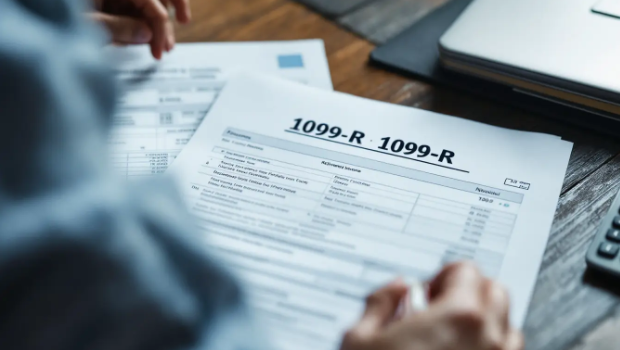Understanding the 1099-R : A Complete Guide

When tax season arrives, many people start receiving forms that they need to file with the IRS. One important document that confuses a lot of taxpayers is the 1099-R . The 1099-R is used to report distributions from pensions, retirement accounts, annuities, IRAs, and certain other types of financial accounts. If you took money out of your retirement savings during the year, chances are you will get a 1099-R.
This article will explain what the 1099-R is, why it is important, who receives it, and how to handle it when filing taxes. We will also go through common mistakes, tips to avoid IRS issues, and answer some frequently asked questions at the end. By the time you finish reading, you should have a clear understanding of this form and how it affects your tax filing.
What is a 1099-R
The 1099-R is an official tax document sent by financial institutions, pension managers, or insurance companies. It reports distributions of $10 or more from retirement accounts and similar financial arrangements. Examples include:
- 401(k) plans
- Individual Retirement Accounts (IRAs)
- Pensions
- Annuities
- Profit-sharing plans
- Certain disability payments
This form is important because most of these distributions are considered taxable income. Even if the money was rolled over into another retirement account, the IRS wants to keep track of the transaction.
Why is the 1099-R Important
The IRS uses the 1099-R to ensure that individuals correctly report income from retirement and other accounts. If you receive money but fail to report it, the IRS will know because they also get a copy of your 1099-R. This can lead to penalties, interest, or an audit.
For taxpayers, the form helps in accurately filling out Form 1040, since you will need to report this income. If you rolled money over into another qualified plan, the 1099-R will also show that, so you don’t end up paying unnecessary taxes.
Who Receives a 1099-R
You will receive a 1099-R if you:
- Withdrew money from your retirement account
- Took a pension payment
- Received annuity distributions
- Got certain disability benefits
- Received a death benefit as a beneficiary
- Had a loan treated as a distribution from a retirement account
Not everyone receives a 1099-R each year. If you didn’t touch your retirement account, you may not get one.
What Information Does the 1099-R Contain
The 1099-R includes several important details:
- Payer information (the institution or company issuing the payment)
- Recipient information (your name, address, and Social Security number)
- Gross distribution (the total amount you received)
- Taxable amount (how much of it is taxable)
- Federal income tax withheld (if any taxes were already taken out)
- Distribution code (a code explaining why you got the money, such as normal retirement, early withdrawal, rollover, etc.)
Understanding the distribution code is very important because it helps determine if you owe extra taxes or penalties. For example, an early withdrawal before age 59½ may come with a 10% penalty unless an exception applies.
When Do You Get a 1099-R
Financial institutions are required to send the 1099-R by January 31st of the year following the distribution. For example, if you took money out in 2024, you will get the 1099-R in early 2025.
If you haven’t received it by mid-February, you should contact your financial institution.
How to Use a 1099-R When Filing Taxes
When you receive a 1099-R , you will need to:
- Review it carefully to make sure the information is correct.
- Enter the amounts from the form on your Form 1040.
- Report both the total distribution and the taxable amount.
- If federal taxes were withheld, include that amount as well.
- Attach additional schedules if necessary.
If you rolled over money into another account, make sure you report it correctly so that you are not taxed on the rollover.
Common Mistakes with the 1099-R
Here are some common errors people make with the 1099-R :
- Not reporting it at all: Some people think that if taxes were withheld, they don’t need to report it. That is wrong.
- Confusing gross distribution with taxable amount: Not all of your distribution may be taxable, especially if part of it was a rollover.
- Ignoring the distribution code: The code explains the type of distribution and whether penalties apply.
- Using the wrong form or schedule: For large or unusual distributions, additional schedules may be needed.
Tips to Handle Your 1099-R Correctly
- Check the numbers: Compare the 1099-R with your own records to ensure accuracy.
- Understand the codes: Look up the distribution code to see if penalties apply.
- Report rollovers: Even tax-free rollovers must be reported.
- Don’t wait until the last minute: If something looks wrong, contact your financial institution early.
- Seek professional help if needed: If you don’t understand the form, a tax advisor can help you avoid mistakes.
Penalties and IRS Issues
Failing to report a 1099-R correctly can result in:
- Additional taxes owed
- Penalties for underreporting income
- A 10% penalty for early withdrawals
- Interest charges on unpaid taxes
- IRS audits
The IRS matches the forms they receive with the forms you file. If there’s a mismatch, you will receive a notice.
Digital vs. Paper 1099-R
Many institutions now offer digital 1099-R s that you can download online. This makes it easier to store, file, and upload directly into tax software. However, some still send paper copies in the mail. Either way, the information is the same, and the IRS gets its own copy.
Conclusion
The 1099-R is a key tax document that reports distributions from pensions, annuities, IRAs, and other retirement accounts. Even if you only rolled over money, you still need to report it. Understanding how to read and use this form will save you from IRS problems, penalties, or paying unnecessary taxes. Always check your form carefully, report it on time, and consult a tax professional if anything seems confusing.
FAQs
Q1: What happens if I don’t get a 1099-R but I took money out?
You are still responsible for reporting the income. Contact your financial institution if you didn’t receive the form.
Q2: Do I pay taxes on the entire distribution?
Not always. Some of the distribution may not be taxable, especially if you rolled it over into another retirement account.
Q3: What is the penalty for early withdrawals?
If you withdraw before age 59½, you may face a 10% penalty plus income taxes, unless you qualify for an exception.
Q4: Can I get my 1099-R online?
Yes, many institutions provide electronic versions through online accounts.
Q5: What should I do if there’s a mistake on my 1099-R?
Contact the payer immediately and ask for a corrected form.





